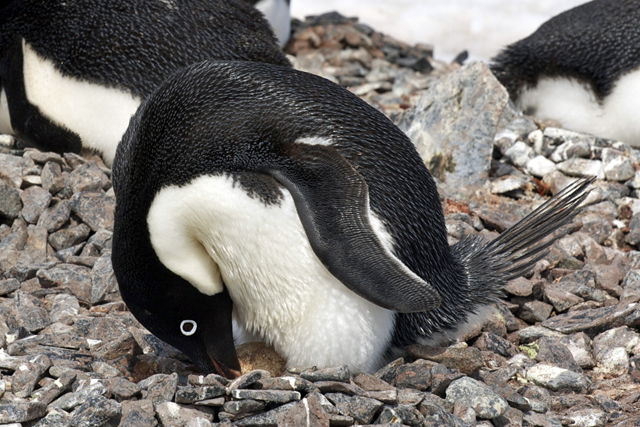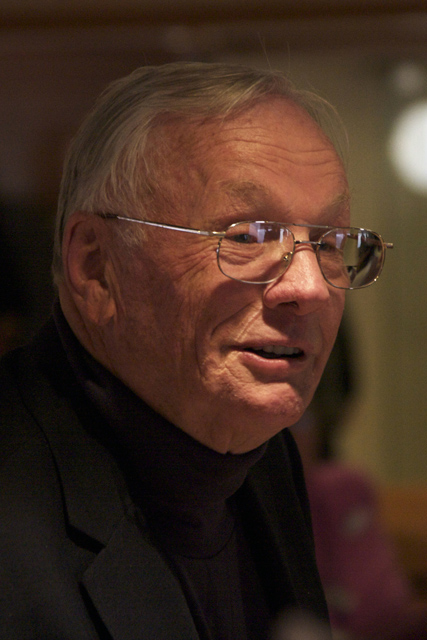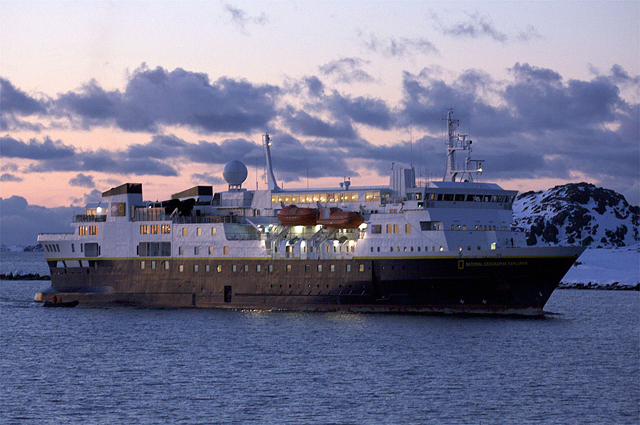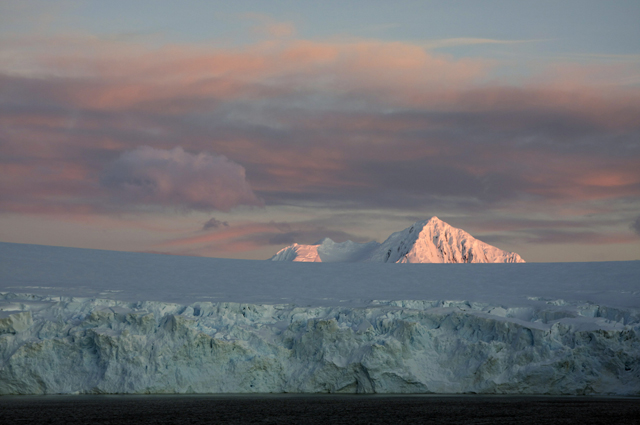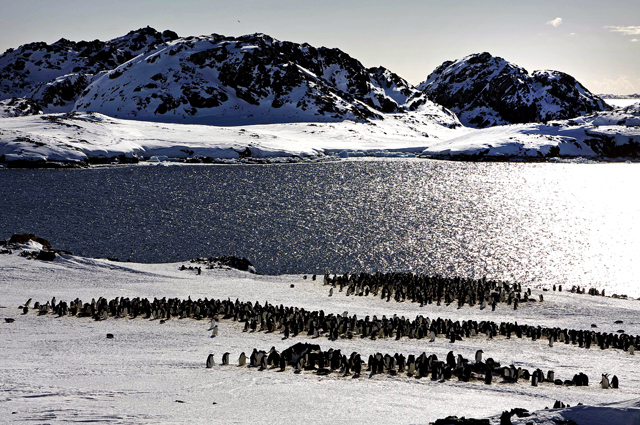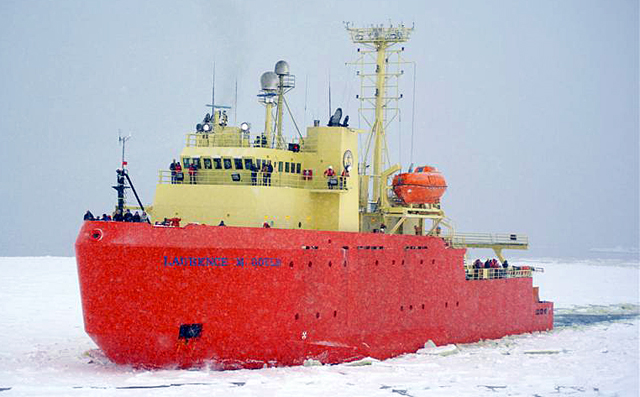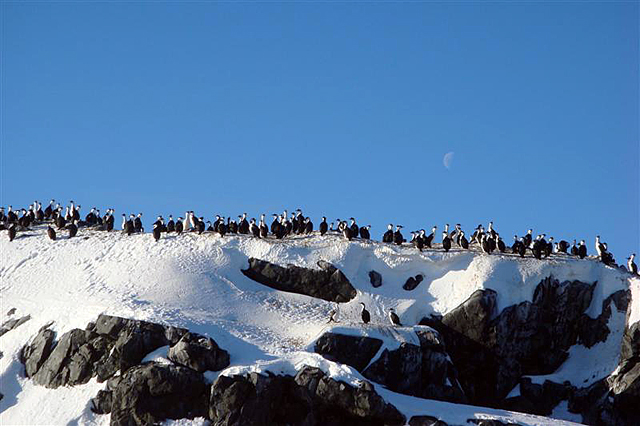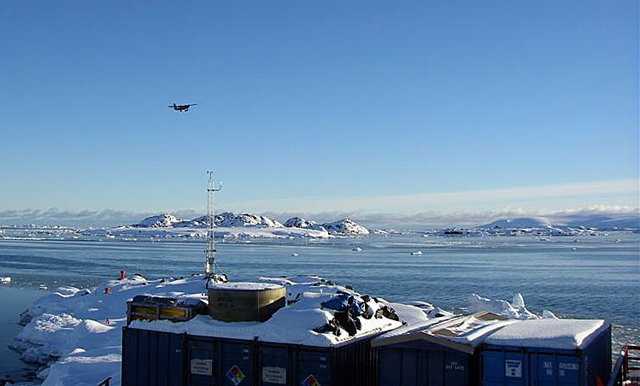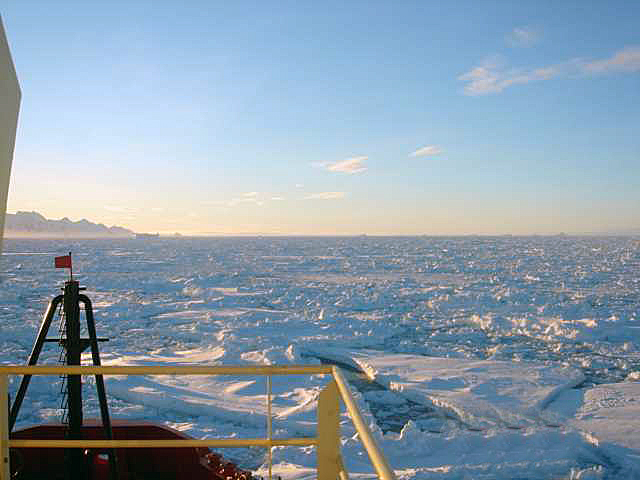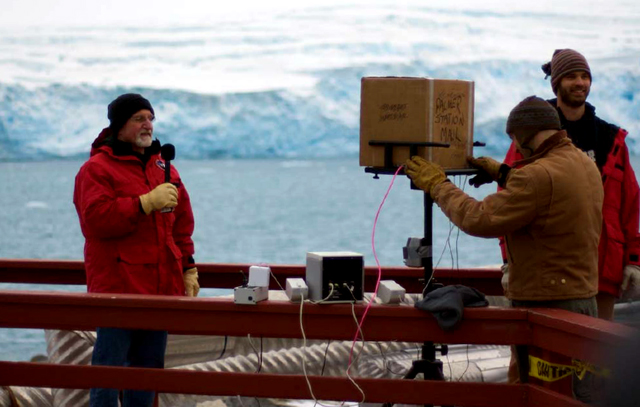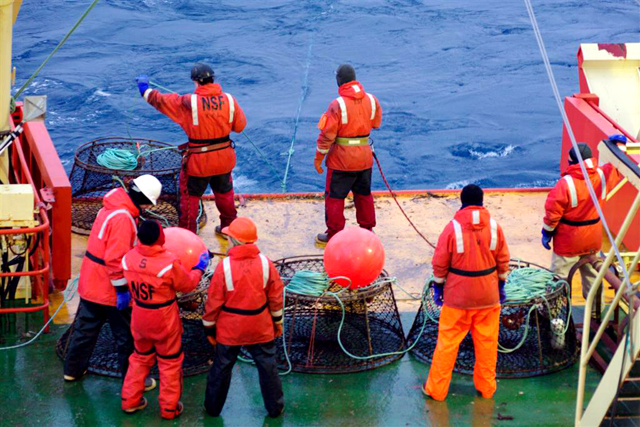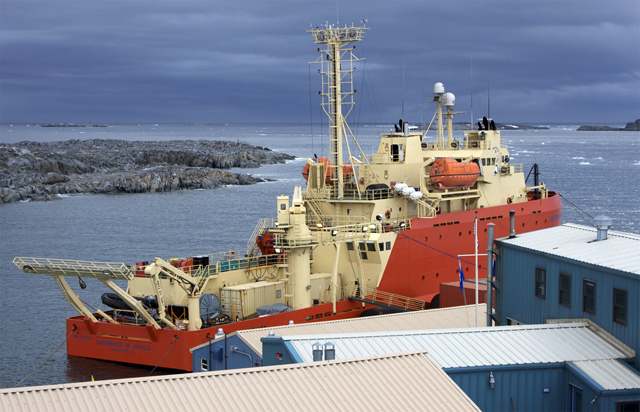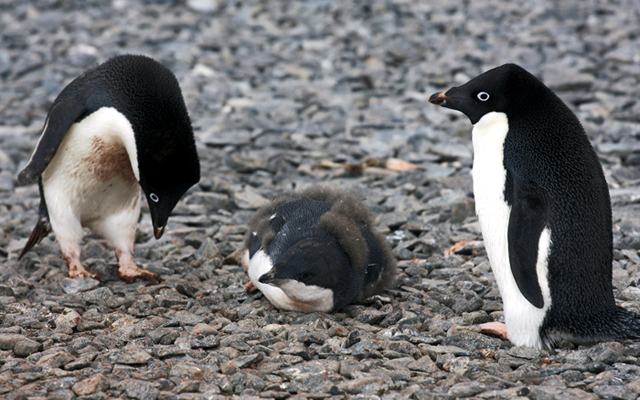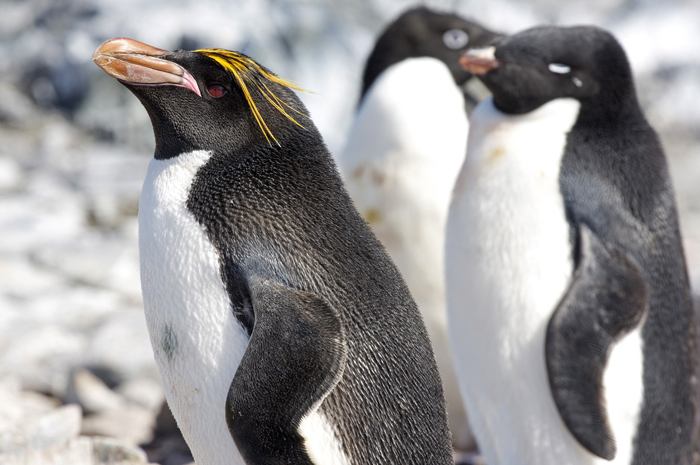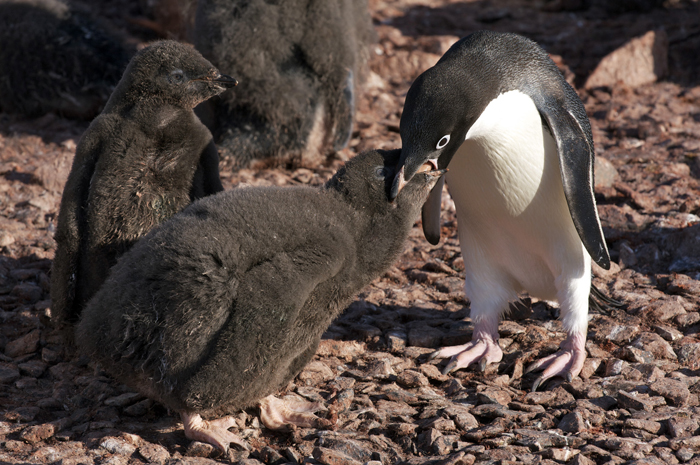|
Palmer Station Archives - 2009 Penguins colonize island recently exposed by retreating glacierPosted December 11, 2009
Of all of our science groups here at Palmer Station’s Bill Fraser’s research team with the Polar Oceans Research Group out of Montana routinely visits most of the islands surrounding the station by Zodiac boat measuring and counting many of the local birds. For safety reasons, all boats communicate by radio with the station when they leave one location and arrive at another, so everyone grows accustomed to hearing the daily travels of the birders, with only rare exceptions to their usual patterns. Several weeks ago, things changed when they announced a detour upon their return from Dream Island. They had discovered the first new penguin colony in this area in more than 10 years. Gentoo penguins had nested for the first time on an unnamed island only recently exposed by the retreating glacier. Because everyone with a radio heard the news, the birders were later welcomed home with a barrage of questions and were excited to share the details. The other two Palmer Long Term Ecological Research (LTER) Schofield’s team has also launched its first automated underwater glider with plans to deploy a second one soon. All three groups are continuing to prepare for January’s LTER cruise. A couple of cruise ships have already brought a number of visitors to station, even though it’s still early in the tourist season. Palmer was honored to have former NASA astronaut Neil Armstrong as a guest a couple of weeks ago, reminding the 30 people on station that even though it sometimes feels like this is the middle of nowhere, the moon above is much, much farther away. The ASRV Laurence M. Gould They and their principal investigator, Christopher Neill (blog We celebrated Thanksgiving this year with everyone sitting down for a traditional feast that was finished off with a plethora of pies. The days have been warmer in the last month and largely above freezing, so the snow is beginning to melt away rapidly and rock is increasingly exposed. Weather has been calm lately, and a rare week of sun left behind a lot of suntans and smiles. On average, it is cloudy 80 percent of the time at Palmer, so such a solid dose of sunshine was a rare treat. It is now no longer dark at night and summer seems in full swing with active science groups and abundant wildlife. NASA plane flies by Palmer Station as summer takes offPosted November 6, 2009
A visiting airplane becomes a big event at a station entirely supported by ships, especially when it’s a NASA 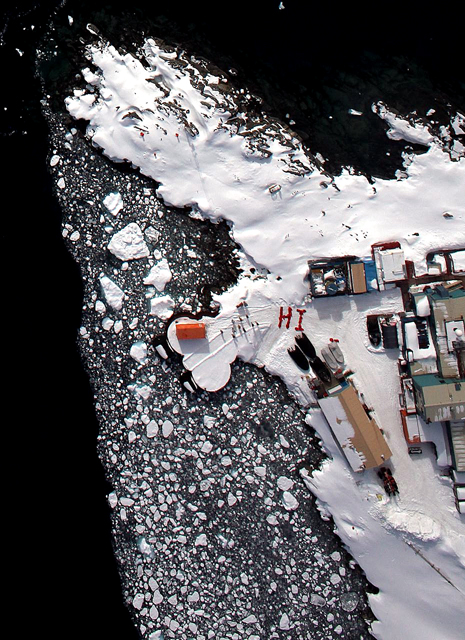
Photo Credit: John Arvesen/NASA
Palmer residents greet a NASA plane flying overhead on a mission to study polar ice.
The space agency’s DC-8 research plane flew over yesterday as part of its Operation Ice Bridge The plane is equipped with instruments to map the shape of the terrain below the ice, which isn’t possible from the usual coverage provided by the agency's dying ICESat satellite. Palmer Station’s Aside from the NASA diversion, Palmer has been a busy station for the last few weeks. The ASRV Laurence M. Gould The Gould also brought Derrold Burnett, the director of Supply Chain Management for Raytheon Polar Services Co. (RPSC) After their departure from Palmer, the Gould’s crew successfully repaired the GPS systems on Hugo Island, a process that took over four attempts because of the notoriously bad weather and ice conditions around the island. The GPS is in support of Eugene Domack’s LARISSA project The beginnings of this summer’s science population also arrived on the Gould, mostly to begin preparations for January’s annual Palmer Long Term Ecological Research (LTER) Oscar Schofield’s phytoplankton group brought along three underwater gliders this year, with high ambitions of launching them to explore the region's “ecological hotspots,” the topic of a recent weekly science lecture. Some of this work is being done in conjunction with Bill Fraser’s group and its study of the local birdlife. “The Birders” are already out in boats visiting islands, watching as the snow melts away to provide the penguins access to the small stones that they use to build nests. Hugh Ducklow’s team is also getting an early start on the summer season before the LTER cruise. They are investigating the mechanisms of climate change on the microbial level in the Antarctic marine ecosystem. Our station has also been busy with wildlife visits. An elephant seal camped out near our seawater pump house for a few days while recovering from what must have been a lost fight for mating rights. Penguins have made a few appearances on station. Nearby Torgersen Island now holds hundreds of Adélie penguins staking claims to nesting spots. Leopard seals are increasing patrols of the shoreline, and the first minke whale was sighted a week ago. Weather extremes have become the norm in our changing season. Days have been either plagued with high winds and snow or calm and clear with warm sun for working outside. Strong winds, though, have often gusted to more than 60 knots and create deep snow drifts all over station. Our days are getting dramatically longer, and soon darkness will become nonexistent. Until then, we’ll hopefully have a few more calm and star-filled nights to enjoy. New summer crew arrives at Palmer StationPosted October 16, 2009
Winter has come to an end here at Palmer Station The summer crew had a longer-than-normal crossing of the Drake Passage, due to some science work conducted en route from the Gould. The scientists aboard the ship, led by Colm Sweeney Many on both sides of the pier were glad when the Gould finally arrived. The new personnel not only assume their normal jobs — such as cook or mechanic — but also take on the responsibility for serving on one or more of several emergency teams. The fire team turnover involved just about the entire station in some form or another. The winter fire team turned over their bunker gear (protective outer gear worn by firefighters) to the summer crew, who received training in the United States before heading south. Part of this process involved a member of the winter team helping a member of the summer team set up his or her fire-gear stations. The new fire team members then practiced donning their gear and using the self-contained breathing apparatus. Finally, each person did a simulated blind search to make sure the gear worked properly. Then it was time for a drill. This required the summer crew to respond as if a real fire was under way, while the outgoing winter fire team shadowed them. This helps ensure that the summer crew could practice gearing up and conduct an exercise while the winter team was still around. After a successful drill, both fire teams met up for a debriefing to discuss the drill and address any areas of concern. 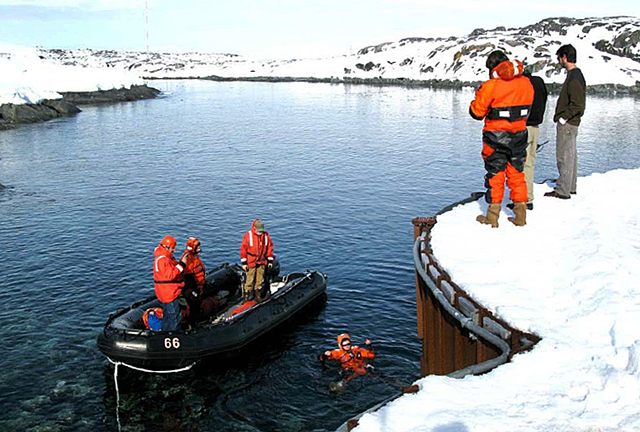
Photo Credit: Rebecca Shoop
The Palmer ocean search and rescue team conducts a drill with the new summer crew.
The turnover of the glacier and ocean search and rescue teams (GSAR and OSAR) was a little less involved, and amounted to little more than just a gear changeover. In the coming weeks, both teams will get more time to train and learn how to best use the resources at hand in the event that they need to respond to an actual emergency. Just as important as personnel turnover was the refueling of the station’s bulk tanks. This year the Gould offloaded 57,000 gallons of fuel. A fueling team assembled to transfer the fuel from the ship. Operating in shifts, the team members set up the fuel hose and walked along the fuel lines to catch any leaks before any fuel was released to the environment. Thanks to careful preparation and the teamwork of all involved, the operation took about six hours without spilling a drop. After a week of turnover, the Gould set sail from Palmer with 11 eager winter-overs glad to be northbound. The sun and wildlife return to Palmer StationPosted September 11, 2009
Winter here at Palmer Station The sun isn’t the only thing we’ve been seeing in the sky. It was during one of the clearest days we’ve had in the past month that a plane from Chile’s Frei Base decided to pay us a visit. We were startled from our lunches with a sound that we haven’t heard this winter. It was as if some Antarctic creature had decided to pay us a visit; everyone in the dining hall was pressed against the windows and then shortly outside taking pictures. After doing a few flybys, the plane disappeared into the clear, blue sky. Such clear blue skies have been more frequent this past month, bringing calm, beautiful days — perfect to get in boats and explore the islands near Palmer. It was on just such a day that most of us left the station for a few hours for some much-needed time off station, and also the first sightings of penguins starting to return to the area. The islands around Palmer, many of which are only open for use during the winter, are popular, alternative locations for recreational activities. Many are perfect for skiing or sledding down the hill on your backside, laughing and having a great time the whole way. Camping is also an option on these islands, though most of the camping has been spent in Palmer’s “backyard” area on Anvers Island. But with temperatures warming and less sea ice, island camping is becoming more attractive. The return of the ARSV Laurence M. Gould Winter isolation also means that the flu or other nasty bugs could arrive on the ship after an uneventful and relatively healthy winter. Preparations are being made to handle anyone who happens to become infected and to help stop the spread of any flu or other illness. Most of us are looking forward to the end of the winter and turning over our jobs to the incoming replacements. And, most of all, the ride back north when the Gould heads back to port to Punta Arenas, Chile, and beyond. Palmer Station emergency teams train for the unexpectedPosted August 7, 2009
With ice filling in both Arthur Harbor and Hero Inlet, winter is making certain we know it’s here at Palmer Station It has been a month from the time the ARSV Laurence M. Gould Compared to the International Polar Year Instead, logistics personnel find their time taken up by inventory. FEMC members are now focusing more on finishing projects rather than helping science groups set up to go with their projects’ needs. This is a much more isolated winter, one in which we must be able to rely on each other. To that end, most folks have their normal jobs, but are also members of an emergency response team of some sort or another. The trauma team meets once a week for an hour for training. Topics can range from how to package patients for transport, how to take vital signs and to give sutures, and even how to take X-rays. Trauma team members also serve as assistants to the doctor when there are patients who need care. This could mean taking vitals over an overnight shift to allow the doctor to sleep, while still keeping an eye on the patient, or even helping with lab work, like during a recent cholesterol screening of station personnel. 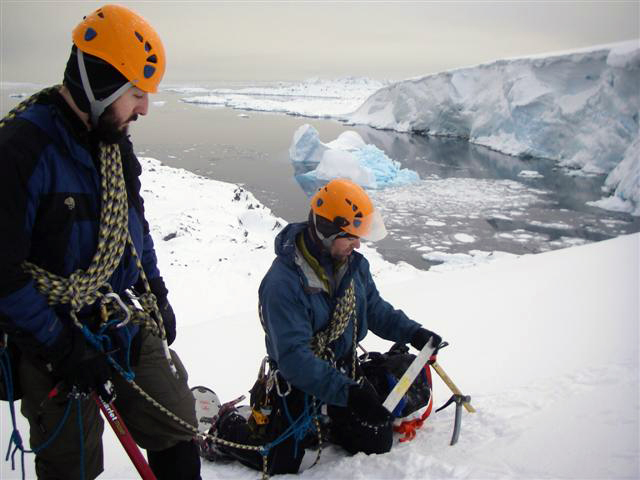
Photo Credit: Susannah Coates/Antarctic Photo Library
Jeff Braucher, left, and Ken Keenan conduct GSAR exercises on a glacier.
Due to Palmer’s marine location and the surrounding islands, the station has a small fleet of Zodiac boats for marine operations, which requires the need for an Ocean Search and Rescue (OSAR) team. Before coming to the station for the season, most of the winter-over crew trained in OSAR at Lake Powell in Arizona. There they learned the basics about search and rescue, such as how to use different safety equipment. Now they apply those basic lessons in monthly exercises around Palmer. Training sessions involve playing hide and seek using GPS, practicing landings in rough swells, learning the surrounding islands in the Palmer boating area, and improving general boating skills. With a glacier behind station, along with some of the icy terrain on the surrounding islands, Palmer also has a Glacier Search and Rescue (GSAR) team. The GSAR trains mostly on the glacier, learning different ways to work safely to rescue anyone who may, for example, have fallen down a crevasse, and then how to transport them either back to station or to a boat if on an island. The last emergency response team on station is the most important — the fire team. Just about everyone on station is involved with responding to a fire alarm. The same group that trained at Lake Powell also trained for a week in Arvada, Colo., learning the skills needed to keep a fire from spreading, and more importantly, how to find and save people who may be injured in a smoke-filled area. So we fill our days with not just our day-to-day jobs but also training and learning skills that we hope we never need to use beyond drills and exercises. With each drill, we learn new things and grow more confident in our ability to respond to a real emergency as needed and as safely as possible. Hazardous waste heads north from Palmer StationPosted July 10, 2009
The past month here at Palmer Station For the past few months, a group of “wasties,” led by Mark Furnish, has been hard at work consolidating and getting ready to ship all of the hazardous waste off the station to the United States for disposal. Furnish and his crew have spent most working hours outside among the milvans, or ship containers, housing the haz waste, and moving it down to the Palmer pier to be loaded onto the ARSV Laurence M. Gould All the long hours of work finally paid off with the Gould’s arrival just before Midwinter’s day, after thick sea ice slowed its arrival. The vessel also made a side trip to Hugo Island to attempt to repair a GPS station after its initial port call, but was unable to make the repair. The waste crew, with help from Palmer Logistics, managed to complete loading of the waste milvans on the pier and finally onto the ship. On the days preceding the departure of the Gould, word had made its way to station that the ship might have to leave a day earlier than planned. It turns out that one of the Chilean stations, Base General Bernardo O’Higgins Riquelme (O’Higgins Base), had lost power and would need the Gould to deliver some parts for a generator. The mission would require the Gould to travel to another Chilean Base, Base Presidente Eduardo Frei Montalva (Frei Base), on King George Island, to pick up some equipment that was being flown there from Punta Arenas, Chile. After the equipment was on board, the Gould would make its way to O’Higgins on the Antarctic Peninsula to unload it. Before going to Frei Base, the Gould attempted a second landing at Hugo Island to try to repair the GPS unit installed earlier this season. The GPS measures the effect of ice-sheet loading and the unloading on the landmass. Unfortunately, large swells stymied the vessel’s return. The Gould attempted to make its way towards Frei Base, only to have to backtrack and take an alternate route due to sea ice. Eventually the mission was canceled altogether because the pack ice at Maxwell Bay prevented the small-boat operations needed to get the replacement parts to the Gould. In the end, the Gould returned to Punta Arenas. It hasn’t been all work at Palmer this past month. Right before the Gould arrived for the hazardous waste run, we celebrated Midwinter’s day a few days early with a splendid dinner. Even though most station personnel were involved in preparing the feast, the main creative force behind it was station chef Eric Cooper. Some highlights from the dinner included smoked salmon mousse, krill bisque, fresh-baked breads, and a roast suckling pig. While the dinner was eaten a few days early, the celebratory polar plunge was held on Midwinter’s day. With the Gould gone, Palmer will be without any new station personnel or science groups until the end of September. While the winter crew is looking forward to finishing out the season, we all realize just how lucky we are to have such a great crew this year. We all wish all the other stations on the Ice a fine Midwinter and hope they are enjoying their winter as much as we are enjoying ours. Palmer goes prime time with Oprah appearancePosted June 5, 2009
Probably the most talked about event at Palmer Station Palmer’s own research associate Neil Scheibe was chosen to participate on a segment on the popular daytime show entitled "Where the Skype Are You" during a recent taping of the show. Appearing with Neil on Oprah was Bruce Sidell Skype is normally not allowed to be used on the U.S. Antarctic Program To ensure a successful Skype with Oprah, a special laptop was set up to have top priority on the network. A side benefit to this was that we needed to test the laptop for usability with Skype and Palmer’s Internet connection. Several station personnel were able to contact and talk with friends and family back home for testing purposes. Science personnel also conducted several outreach Skype sessions with schools back stateside. When it came down to the big day, we were lucky enough to have clear skies that enabled Oprah and her viewing audience a view of the glacier behind Palmer. Both Neil and Bruce did a great job telling Oprah and her audience about station life and the effects of global warming to the environment around Palmer. About two weeks after taping, the show aired to a packed Palmer lounge. The LMG has brought two science groups to the station for a six-week cruise. The group led by Sidell (University of Maine) and Kristin O’Brien (University of Alaska Fairbanks) Douglas Nowacek, with Duke University Soon the current LMG cruise will come to an end and with it the current science season here on station. The next work includes a hazardous waste run in the coming weeks. After that, Palmer will just be left with its winter-over crew to finish out the season. Season turn-over complete at PalmerPosted May 1, 2009
After starting out with a busy first week in April, thanks to turnover with the summer crew and fueling operations, the winter personnel at Palmer Station 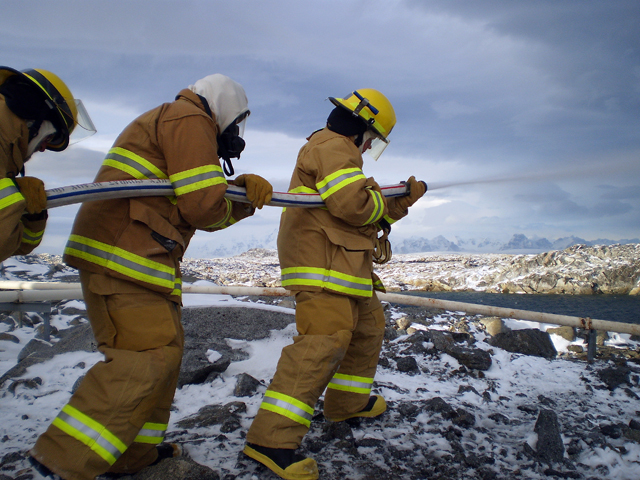
Photo Credit: Ken Keenan
Palmer personnel Greg Cocco, Harry Snyder and Sean Bonnette conduct a fire drill.
Most of the winter crew was lucky enough to join Robert Blanchette’s The Palmer winter-overs took the opportunity to explore both Whales Bay and Pendulum Cove. Thanks to the warming effects of thermal vents under the sands of Pendulum Cove, just about everyone abroad the ARSV Laurence M. Gould During the week of turnover, the Gould, along with Eugene Domack’s Back at Palmer, the winter fire team completed it turnover duties, with a combination drill and training exercise that successfully extinguished a mock fire in the clothes dryer on the second floor of the GWR (garage, warehouse and recreation) building. Another drill followed the next week that gave the fire team the chance to practice using charged hose lines, and to rescue an unconscious victim from the Boathouse. With the onset of winter fast approaching, the penguins around station have left the area except for a few stragglers. While out on a boating trip, a small group of station personnel witnessed firsthand the role of penguins in the food chain when a leopard seal attacked a lone gentoo penguin. In an instant, the leopard seal had emerged from the water under the gentoo, its mouth firmly grasping the penguin as it leapt from the water like a breaching whale, to return back under the ice-blue water with its fresh catch. The Gould left the winter crew with a night departure and the remaining station personnel did a polar plunge to wish those leaving a safe trip north. Winter changes under way at PalmerPosted March 16, 2009
Winter is quickly approaching at Palmer Station 
Photo Credit: Jon Brack
Jeff Otten, Ryan Wallace, Louise Hamlin and Kevin Lindburg, from left, change out a survival cache on Outcast Island near Palmer Station. The cache contains things like tents and stoves should someone spend unexpected night off the station.
We had a rare, clear night sky two weeks ago, with a dense blanket of stars, which happened to be on the night the Kepler Telescope Louise Hamlin, the research associate responsible for all science at Palmer of a geophysical nature, was the principal instrument engineer for NASA’s Jet Propulsion Laboratory Other excitement on station has surrounded some unexpected guests. A group of scientists under Ross MacPhee Both MacPhee, from the American Museum of Natural History Our local scientists have been busy with everything from weighing bird chicks to sampling seawater. Oscar Schofield’s The “Birders,” Bill Fraser’s seabird ecology group, have included many station volunteers in the process of weighing and measuring fledging Adélie penguin chicks. Chicks have to be measured when their chick-down is almost gone and new feathers have grown in completely. These chicks still haven’t figured out their need to feed themselves now that the parent penguins have abandoned them to molt before the winter approaches. The Birders have spent their remaining time mainly studying the local skua and giant petrel populations, species far less rigorous in their breeding cycles, which won’t see their offspring leave the nest for several more months. The final cruise ship of the season will visit the station this week, concluding an active and interesting summer of visitors. Fewer ships made the trip this year than previously, but we still managed to share our science and home with hundreds of happy and curious guests. Our search and rescue (SAR) teams are also finishing a safe and productive season. Ocean SAR has changed out two island survival caches and Glacier SAR practiced a double haul system, successfully dragging a snowmobile on the ice. Most people on station will depart with the next arrival of the Gould, and we are preparing for a busy turnover with the new station members. The increasing darkness and change in weather are signs that it’s time to leave and pass our home off to the next occupants. After seven months here, it will be both a sad and welcome departure. Wildlife action peaks at PalmerPosted February 6, 2009
Wildlife has been a highlight of the last month at Palmer Station The penguin chicks have grown dramatically in the last month to nearly the same size as their parents. In the last week most have begun to molt and will soon fledge their nests for the first time. The “Birders,” a nickname for Bill Fraser’s research team, have continued a busy summer schedule studying almost everything with feathers on all of the nearby islands. They’re currently in the process of weighing and measuring chicks before nests are left behind as species move north for the winter. We had one rare sighting of a stray Macaroni penguin amongst the Adelies on Torgersen Island. Their usual habitat is far north of here, so it was a surprise to encounter one this far from their normal warmer habitat. Daily sightings of humpback whales, by the scientists in Zodiac boats and from the dining facility windows at the station, have become common, and are enjoyed by all. The two Palmer artists-in-residence are sometimes the first to spot these giants of the deep when they’re out working on their month-long projects. Oona Stern (blog Cheryl Leonard (blog Norbert Wu, a famed underwater photographer known for his Antarctic images from the Ross Sea, is at Palmer for the first time diving and photographing the underwater habitats here. He and his assistant Conor McCracken have been making at least two Zodiac-based dives a day, after which they can often be seen snorkeling in Hero Inlet getting as much time in the water as possible during their month on station. We have hosted a few scheduled tour ships this month, some as big as cities and others as small as houses. Passengers from the smaller ships come ashore for a tour of the station and for a chance to indulge in our Antarctic-famous brownies. The visitors are always thrilled for the opportunity to see the station and hear firsthand about the science happening at Palmer. The U.S. Antarctic Program Our station population is up to 32, the highest it’s likely to get this summer season. The station continues to be both quiet and active, subtly tucked away on our little rocky outcropping amongst some of the most beautiful scenery on the Antarctic Peninsula. We all feel lucky to live and work in such a place as this, complete with everything from ugly molting penguins to playful humpback whales. |
Home /
Around the Continent /
Palmer Station Archives - 2009
"News about the USAP, the Ice, and the People"



For USAP Participants |
For The Public |
For Researchers and EducatorsContact UsU.S. National Science FoundationOffice of Polar Programs Geosciences Directorate 2415 Eisenhower Avenue, Suite W7100 Alexandria, VA 22314 Sign up for the NSF Office of Polar Programs newsletter and events. Feedback Form |

